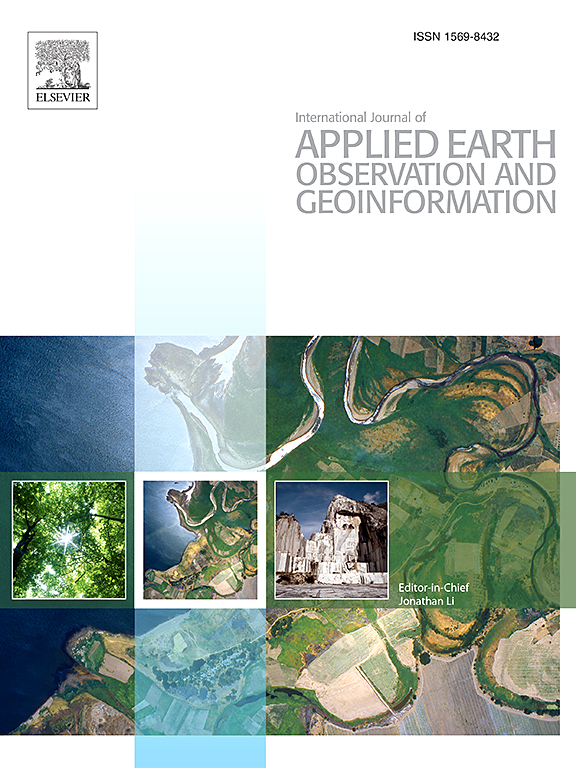Soil organic carbon estimation using spaceborne hyperspectral composites on a large scale
IF 7.6
Q1 REMOTE SENSING
International journal of applied earth observation and geoinformation : ITC journal
Pub Date : 2025-05-14
DOI:10.1016/j.jag.2025.104504
引用次数: 0
Abstract
Soil Organic Carbon (SOC) is a key property for soil health. Spectral reflectance such as multispectral and hyperspectral data could provide efficient and cost-effective retrieval of SOC content. However, constrained by the availability of hyperspectral satellite data, current works mostly use a small number of spaceborne hyperspectral imagery for SOC retrieval on a small scale. In this work, the first large-scale hyperspectral imaging reflectance composites were built, and they were used for SOC estimation. Specifically, DESIS satellite images were used to predict SOC over the whole state of Bavaria in Germany ( 70,000 km). We prepare 850 hyperspectral images from the DESIS satellite and build temporal composites from them. For the soil data, data was gathered from LfU(Bavarian State Office for the Environment), LfL(Bavarian State Research Center for Agriculture) and LUCAS 2018 (Land Use and Coverage Area Frame Survey). 828 soil samples were selected after data filtering. For this regression task, different machine learning and deep learning methods were implemented and explored. Moreover, a spectral attention mechanism was added to the model. Besides hyperspectral input, the digital elevation model (DEM) was also included as an auxiliary input as the measured spectrum has inter-variability dependent on the elevation and the generated topographical features are also relevant with SOC distribution. Based on the regression results evaluated by , , and , the deep learning models showed much better performance than machine learning methods. Especially when only using hyperspectral data as input, the best result was achieved with 1.947%, 0.626, and 1.710 on the test set. After incorporating topographical features, the fused model achieved further improved performance with 1.752% and 0.695 and 1.919. From the interpretability analysis for model performance, it was found out that the bands in the range of 530 nm–570 nm, 770 nm–790 nm, and 840 nm - 870 nm are the most relevant bands for SOC estimation. In the end, several SOC maps were generated and analyzed together with soil types. The SOC maps indicate that water-associated areas, such as coastal soils and bogs, tend to have higher SOC, while mountain areas tend to contain lower SOC. Such findings align with SOC distribution across soil types and show the effectiveness of the model.
基于星载高光谱复合材料的大尺度土壤有机碳估算
土壤有机碳(SOC)是土壤健康的关键属性。光谱反射数据,如多光谱和高光谱数据,可以提供高效和经济的SOC含量检索。然而,受限于高光谱卫星数据的可用性,目前的工作大多是在小范围内使用少量的星载高光谱图像进行SOC检索。本文首次构建了大规模高光谱成像反射率复合材料,并将其用于有机碳估算。具体来说,DESIS卫星图像用于预测德国整个巴伐利亚州(~ 70,000平方公里)的SOC。我们准备了850张DESIS卫星的高光谱图像,并利用它们构建了时间复合图像。土壤数据的数据来自巴伐利亚州环境办公室(LfU)、巴伐利亚州农业研究中心(LfL)和LUCAS 2018(土地利用和覆盖面积框架调查)。经数据滤波后,共筛选出828个土壤样品。对于这个回归任务,实现和探索了不同的机器学习和深度学习方法。此外,在模型中加入了谱注意机制。除了高光谱输入外,还包括数字高程模型(DEM)作为辅助输入,因为测量光谱具有依赖于高程的互变性,并且生成的地形特征也与有机碳分布有关。基于RMSE、R2和RPIQ评估的回归结果,深度学习模型的性能明显优于机器学习方法。特别是当只使用高光谱数据作为输入时,在测试集上RMSE为1.947%,R2为0.626,RPIQ为1.710,获得了最好的结果。融合地形特征后,模型的RMSE为1.752%,R2为0.695,RPIQ为1.919,进一步提高了模型的性能。通过对模型性能的可解释性分析,发现530 nm ~ 570 nm、770 nm ~ 790 nm和840 nm ~ 870 nm波段是与SOC估算最相关的波段。最后,生成了土壤有机碳图谱,并结合土壤类型进行了分析。有机碳地图表明,与水有关的地区,如沿海土壤和沼泽,往往具有较高的有机碳,而山区往往含有较低的有机碳。这些发现与不同土壤类型的有机碳分布一致,显示了模型的有效性。
本文章由计算机程序翻译,如有差异,请以英文原文为准。
求助全文
约1分钟内获得全文
求助全文
来源期刊

International journal of applied earth observation and geoinformation : ITC journal
Global and Planetary Change, Management, Monitoring, Policy and Law, Earth-Surface Processes, Computers in Earth Sciences
CiteScore
12.00
自引率
0.00%
发文量
0
审稿时长
77 days
期刊介绍:
The International Journal of Applied Earth Observation and Geoinformation publishes original papers that utilize earth observation data for natural resource and environmental inventory and management. These data primarily originate from remote sensing platforms, including satellites and aircraft, supplemented by surface and subsurface measurements. Addressing natural resources such as forests, agricultural land, soils, and water, as well as environmental concerns like biodiversity, land degradation, and hazards, the journal explores conceptual and data-driven approaches. It covers geoinformation themes like capturing, databasing, visualization, interpretation, data quality, and spatial uncertainty.
 求助内容:
求助内容: 应助结果提醒方式:
应助结果提醒方式:


